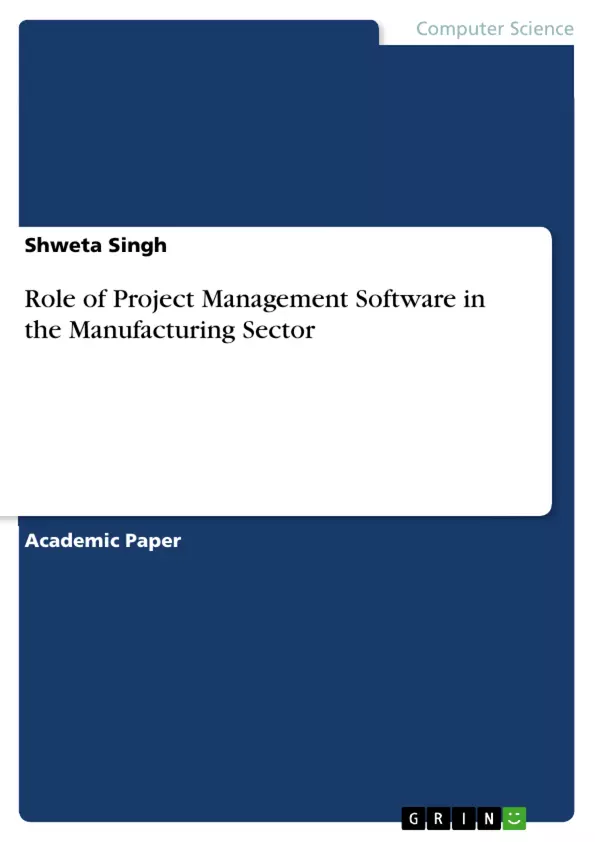The following research questions were determined to support the research objectives: What are the challenges faced by the manufacturing industries using only conventional Gantt charts and work breakdown structure manufacturing industries in managing and optimization of data? What factors contributed to the development of automated and cloud-based project management software in the manufacturing industry? What is the role of automation in project management software? How has automated and cloud-based project management manufacturing software like Jira and Asana effectively contributed to its role in manufacturing industries ?
This study is significantly important from both theoretical and practical perspectives. Theoretically speaking, the findings of this study will review new theories in the existing literature which will help the scholars in further exploring the subject from the manufacturing perspective. Since, the past studies are mostly based on the construction, defence, and service sector and mostly on software development; this study will focus mainly on the implementation of project management in the manufacturing industry with the adoption of modern tools like Jira and Asana in this sector. Alternatively, the empirical investigation in this research could provide a reasonable rather logical overview of the strategies to practitioners and academics for the introduction of APM in the environment of traditional project management in the area of manufacturing which is still under-explored by past researchers. In addition, this research will also guide the project managers with the help of empirical research in identifying the drivers due to which APM has been introduced and the challenges the project managers would face in applying those in the manufacturing industries. This study is aimed to comprehend the role of cloud-based and automated tools, Jira and Asana in effective project management: by investigating the manufacturing sector.
Inhaltsverzeichnis (Table of Contents)
- Chapter 1 Introduction
- 1.1 Background
- 1.2 Problem statement
- Research Question
- Research Framework
- Chapter 2 – Literature review and hypothesis testing
- 2.1 Introduction
- 2.2 Project management in the manufacturing industry
- 2.2 Project management tools
- 2.2.1 Gantt charts
- 2.2.2 Work Breakdown Structure (WBS)
- 2.3 Drivers of cloud-based and automated tools in manufacturing project management
- 2.3.1 Cost-saving
- 2.3.3 Privacy and security
- 2.4 Role of JIRA and Asana in project management
- 2.4.1 JIRA an agile project management tool and software
- 2.4.2 ASANA an agile project management tool and software
- 2.5 Research gap
- Chapter 3 Research Methodology
- 3.1 Introduction
- 3.2 Objectives
- 3.2.1 Hypothesis
- 3.3 Research Design
- 3.4 Target Group
- 3.5 Sample
- 3.5.1 Sample Size
- 3.5.2 Sampling Method
- 3.6 Data Collection Method
- 3.6.1 Primary Data
- 3.6.2 Secondary Data
- 3.7 Conceptual Framework and Variables
- 3.7.1 Conceptual Framework
- 3.7.2 Defining Variables
- 3.7.3 Indirect variables (IV)
- 3.7.4 Control variables
- 3.7.5 Direct variable (y)
- 3.8 Questionnaire Design
- 3.9 The application of tools for Analysis
- 3.10 Application of Ms Excel for Analysis
- 3.11 Research limitation
- Chapter 4 Results and Findings
- 4.1 Descriptive Statistics
- 4.2 Test of Association
- 4.2.1 Z-test
- 4.2.2 Chi-Square test
- 4.2.3 one way ANOVA
- 4.2.4 Correlation
- 4.3 Regression analysis
Zielsetzung und Themenschwerpunkte (Objectives and Key Themes)
This research investigates the role of project management software within the manufacturing sector, specifically exploring the impact of cloud-based and automated tools. The study aims to analyze the effectiveness of these tools, assess their impact on project cost and time management, and evaluate their contribution to improved efficiency and productivity in the manufacturing industry.
- The impact of project management software on project efficiency and productivity
- The role of cloud-based and automated tools in enhancing project management in the manufacturing sector
- The relationship between project management software and cost and time management in manufacturing projects
- The impact of software tools like JIRA and Asana on agile project management practices
- The challenges and benefits of implementing project management software in the manufacturing industry
Zusammenfassung der Kapitel (Chapter Summaries)
Chapter 1 provides a comprehensive introduction to the research topic, outlining the background, problem statement, research question, and the framework guiding the study. Chapter 2 delves into the existing literature on project management within the manufacturing industry, examining different project management tools, including Gantt charts and Work Breakdown Structures. It further investigates the drivers behind the adoption of cloud-based and automated tools in project management, emphasizing the importance of cost-saving, efficiency, and data security. This chapter also explores the specific roles of JIRA and Asana as agile project management tools and software. Chapter 3 focuses on the research methodology employed in the study. It outlines the research objectives, hypothesis, design, target group, and sample size. The data collection methods used, both primary and secondary, are detailed. Chapter 3 also presents the conceptual framework and defines the variables involved in the research. The chapter concludes by discussing the questionnaire design, data analysis tools, and limitations of the study. Chapter 4 presents the results and findings of the research. It includes descriptive statistics, tests of association, and regression analysis. The results provide insights into the relationships between project management software, efficiency, cost, time, and other key factors in the manufacturing industry.
Schlüsselwörter (Keywords)
This research focuses on project management software, cloud-based tools, automated tools, manufacturing industry, project efficiency, productivity, cost management, time management, agile project management, JIRA, Asana, research methodology, data analysis, statistical analysis.
- Quote paper
- Shweta Singh (Author), Role of Project Management Software in the Manufacturing Sector, Munich, GRIN Verlag, https://www.grin.com/document/1300980



